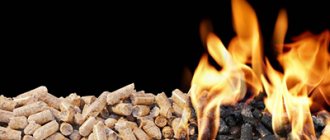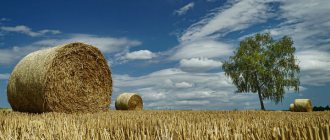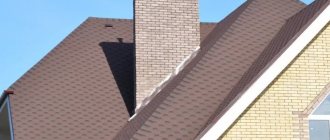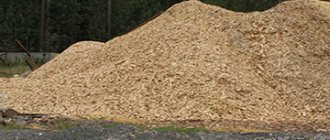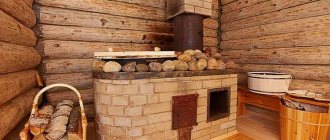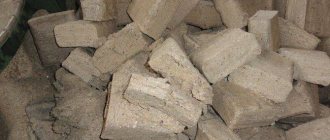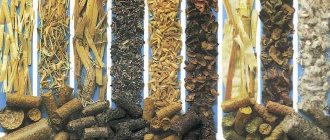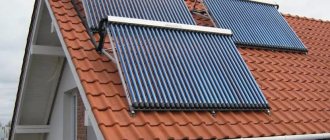The appearance on the domestic market and active popularization of such an energy carrier as fuel briquettes poses some difficulties for users of boiler equipment that runs on coal and wood. In order to make a choice, you should understand in detail what briquettes for heating (or Euro-firewood) are.
Fuel briquettes are used as fuel for solid fuel boilers, stoves and fireplaces
What are fuel briquettes?
Fuel briquettes are a relatively new type of solid fuel. They are made by pressing fine-grained raw materials of natural origin. Sawdust, wheat, rice or buckwheat husks, and sunflower husks can be used as such raw materials. In addition, fuel briquettes are pressed from leaves, straw, reeds, tree bark, and pine needles. Pellets are also made from reeds.
During the pressing process, strong pressure is applied to the raw materials from which wood briquettes are made, resulting in the release of a special substance - lignin. It acts as a connecting component. Thus, no additional chemicals are used in the production of wood pellets, which makes such fuel environmentally friendly.
Various types of raw materials can be used for the production of fuel briquettes
The release of lignin is only possible in cases where significant pressure is applied to the raw materials from which wood briquettes are made. It is quite difficult to fulfill this condition when making fuel briquettes with your own hands using homemade equipment, so in such cases binders are added to the raw material mixture. Clay, wallpaper glue, soaked paper or cardboard can be used as the latter.
Pressed briquettes for combustion can differ not only in the material of manufacture and the degree of density of the internal structure, but also in their geometric parameters, in particular shape and size.
Scheme of the technological process for producing briquettes
Composition of briquetted fuel
Dense bars of fuel are made from waste wood, that is, in fact, they are compressed sawdust. Before being put under the press, the raw material undergoes special preparation: it is crushed to the required size and dried.
Important! Sawdust binders are organic compounds that are safe and do not contain glue.
When pressed, hard briquettes are formed from the raw materials, ready for use. The manufacturer can additionally process them by firing, if such a stage is provided for in the fuel manufacturing process.
The resulting material for heating stoves is delivered to the consumer, who can safely heat his home, non-residential buildings or light a fireplace in the country. Briquettes will replace firewood when traveling outdoors. They will ensure the fire burns evenly, the coals will not fly away and spark.
Main varieties
There are three main types of Euro firewood offered on the modern market, which, while not having any fundamental differences in composition, differ from each other in the density of the internal structure and geometric shape:
- fuel briquettes RUF (RUF);
- European firewood Pini Kay (Pini Kay);
- fuel briquettes Nestro (Nestro).
Fuel briquettes Ruf
RUF wood briquettes, for the production of which sawdust, small chips or shavings are used, have the shape of a rectangle. They are distinguished by the lowest price when compared with other types of pellets. When using such fuel briquettes, it should be borne in mind that the heating boiler must be equipped with a forced ventilation system.
Fuel briquettes "Pini Kay"
Pini Kay fuel briquettes are fired at the final stage of production, which makes them more resistant to high humidity. Pellets of this type differ from RUF fuel briquettes in their geometric shape: in cross section they can have the shape of a cylinder or hexagon with a hole in the central part. Thanks to this hole, they can be successfully used even in ovens that are not equipped with a forced ventilation system. The cost of pellets of this type, which can be easily distinguished from RUF fuel briquettes even from a photo, is higher, which is explained by the more complex technology of their production.
Round fuel briquettes Nestro
Kinds
The method of processing raw materials plays an important role. Taking into account the manufacturing process, briquettes can be divided:
- Piny-kay. Fuel having the highest density of 1.40 g/cm3. The shape is similar to a cube or hexagon, which has a hole in the middle. The air inside the cavity ensures even combustion.
- Low density products – 0.8 g/cm3. These are squares or rectangles made from the smallest particles of material. They are characterized by high thermal conductivity and long-lasting combustion. Convenient to store and transport, do not take up much space.
- Products made from large sawdust with medium density. Their disadvantages include rapid combustion, frequent loss of shape and deformation. Due to low production costs, they have a relatively low price.
Fuel briquettes or regular firewood: what to choose?
What to give preference to: regular firewood or fuel briquettes? To answer this question, we need to study the advantages and disadvantages of both.
Let us list the most important advantages of fuel briquettes:
- A fuel briquette, when compared with conventional firewood, burns 4 times longer than the latter, which contributes to the economical consumption of such fuel.
- After combustion of pellets, very little ash remains - about 1% of the total mass of fuel used. When using conventional firewood, this figure can reach up to 20% of the total mass of fuel used. The ash remaining after the combustion of wood or any other type of briquettes can be used as a fertilizer containing a large amount of potassium.
- The amount of thermal energy released when burning Eurowood is almost twice as much as when using conventional firewood.
- During combustion, fuel briquettes emit heat almost all the time, which cannot be said about ordinary firewood, the heat transfer of which decreases rapidly as it burns.
- When burned, fuel briquettes practically do not spark and emit a minimal amount of smoke and odor. Thus, this type of fuel does not create discomfort and does not harm the environment. In addition, when burning firewood contaminated with mold or mildew, toxic smoke is generated, which is excluded when using Euro firewood, for the production of which carefully dried sawdust or shavings are used.
- When using wood briquettes as fuel, significantly less soot is deposited on the walls of chimneys than when using conventional firewood.
- The compact dimensions that distinguish Eurowood allow for more economical use of the space for storing such fuel. Moreover, when storing fuel briquettes, which are usually placed in neat packaging, no debris and wood dust are generated, which are necessarily present in places where ordinary firewood is stored.
Compact storage is the indisputable advantage of fuel briquettes
Naturally, this type of fuel also has certain disadvantages:
- Due to the high density of the internal structure, fuel briquettes take a long time to flare up; it will not be possible to quickly warm up a room using such fuel.
- The low moisture resistance of Euro firewood can cause it to simply deteriorate if the required storage conditions are not provided.
- Fuel briquettes, which are compressed sawdust, are characterized by fairly low resistance to mechanical damage.
- When burning fuel briquettes, there is no such beautiful flame as when using conventional firewood, which somewhat limits the use of pellets as fuel for fireplaces, where the aesthetic component of the combustion process is also very important.
Comparison of the main parameters of various types of solid fuel
To decide between fuel briquettes and regular firewood, you should take into account the advantages of the latter.
- When burning ordinary firewood, as mentioned above, more heat is generated; accordingly, with the help of such fuel you can quickly warm up a heated room.
- The cost of ordinary firewood in comparison with fuel briquettes is much lower.
- Firewood is more resistant to mechanical damage.
- When burning wood, a beautiful flame is formed, which is a particularly important quality for fireplace fuel. In addition, when wood burns, essential oils contained in wood are released into the surrounding air, which has a beneficial effect on the nervous and respiratory systems of a person in a heated room.
- The characteristic crackling sound that firewood makes when burning also has a beneficial effect on the nervous system.
- The ash remaining after burning conventional firewood does not have such a tart smell as the product of pellet combustion.
Economic component
When deciding between regular firewood and fuel briquettes, you should also take into account the cost of both types of solid fuel. Euro firewood, which is produced today by many domestic manufacturers, on average costs 2–3 times more than regular firewood. Meanwhile, inexpensive ordinary firewood is rarely of uniform quality.
Most often, the total mass of firewood contains only 20–30% of well-dried logs, while up to 50% of the total mass of purchased firewood can be logs with high humidity, and 20–30% may be stale firewood of not very high quality. If we talk about fuel briquettes, then the moisture content of such fuel, for the production of which well-dried sawdust is used, does not exceed 9%.
Briquettes clearly outperform firewood in terms of transportation
When making a choice between fuel briquettes and firewood, you can also take into account the following facts.
- The burning time of fuel briquettes, which is about two hours, is almost twice the period during which ordinary firewood burns.
- The heat transfer of firewood, which is especially noticeable when located in close proximity to a heating boiler, is significantly higher than that of fuel briquettes.
- The amount of ash remaining after burning fuel briquettes is approximately ¼ less than the amount of combustion products remaining after burning conventional firewood.
Thus, pellets are better used as fuel for long-burning boilers, and ordinary firewood is more suitable for lighting fireplaces. In any case, when making a choice in favor of one or another type of solid fuel, you should be guided by all of the above facts, and also take into account the type of heating equipment.
Advantages and disadvantages
Heating with alternative fuels has its positive and negative sides.
Pros:
- High calorific value and heat transfer. These indicators are significantly higher for alternative fuels than for conventional logs.
- Long burning time. Therefore, their consumption is significantly less than that of firewood or coal.
- Uniform combustion. Briquettes burn without unnecessary noise and smoke. And they produce less ash than coal or firewood. This makes it easier to clean the oven device after use.
- Slight release of tarry substances. Thanks to this, the chimney does not become clogged.
- Long shelf life. Briquettes can be stored from 1 to 5 years (depending on manufacture).
- Environmentally friendly. The product is natural, without various impurities. Safe for people and the environment.
Minuses:
- Briquette fuel prices are higher. Firewood is much cheaper. But thanks to economical consumption, the costs are worth it.
- Purchasing such goods in some cities or towns is difficult.
- Products should be stored in accordance with the instructions. Therefore, you should prepare a clean and dry place.
- The ash gives off a pungent odor.
How to make using pellets more profitable
You can make the use of pellet fuel economically profitable if you make briquettes yourself. By creating equipment that can be operated either manually or through a hydraulic mechanism, you can independently produce fuel briquettes for your needs from straw, wood waste, as well as fuel briquettes from sunflower husks and other waste remaining after processing agricultural raw materials. Naturally, you can organize your own production of fuel briquettes only if you have access to a sufficient amount of cheap raw materials.
Homemade manual briquette press with two dies
Homemade equipment for making fuel briquettes, as mentioned above, can be operated manually, using a lever or screw mechanism, or operated through a hydraulic mechanism, which can be used as a car jack. Regardless of the type of drive, the main design elements of a device intended for the production of pellets are:
- a matrix in the working cavity of which the formation of a fuel briquette occurs;
- a punch, which, by exerting pressure on bulk raw materials, compresses it;
- a mixing drum, where the components from which the fuel briquette will be formed are mixed;
- loading and unloading trays;
- a powerful frame on which all structural elements of the device are fixed.
When making pellets using homemade equipment, you should keep in mind that a binder must be added to the mixture from which fuel briquettes will be formed. As such a substance, ordinary clay, wallpaper glue, soaked paper and cardboard can be used.
How much are?
The price of briquettes for heating a furnace depends on the technology and material from which the product is made.
- Alternative fuel of the Pini-kay type made from pine needles will cost an average of 8,900 rubles. for one ton, from birch - from 9,500 rubles.
- RUF briquettes are cheaper: sawdust 6500, pine needles 6000, pine and birch 6500, birch 6900 rubles.
- Nestro briquettes are the most inexpensive: 7500 per ton. Peat briquettes will cost the stove owner 8,000 rubles, and coal briquettes – 9,500 rubles.
You can purchase briquettes in specialized stores, as well as on websites on the Internet. Online shopping will be a little more profitable, since you will not have to pay for the services of consultants and renting store premises. But in the store you can personally see the quality of such a purchase, which is very difficult to do via the Internet.
